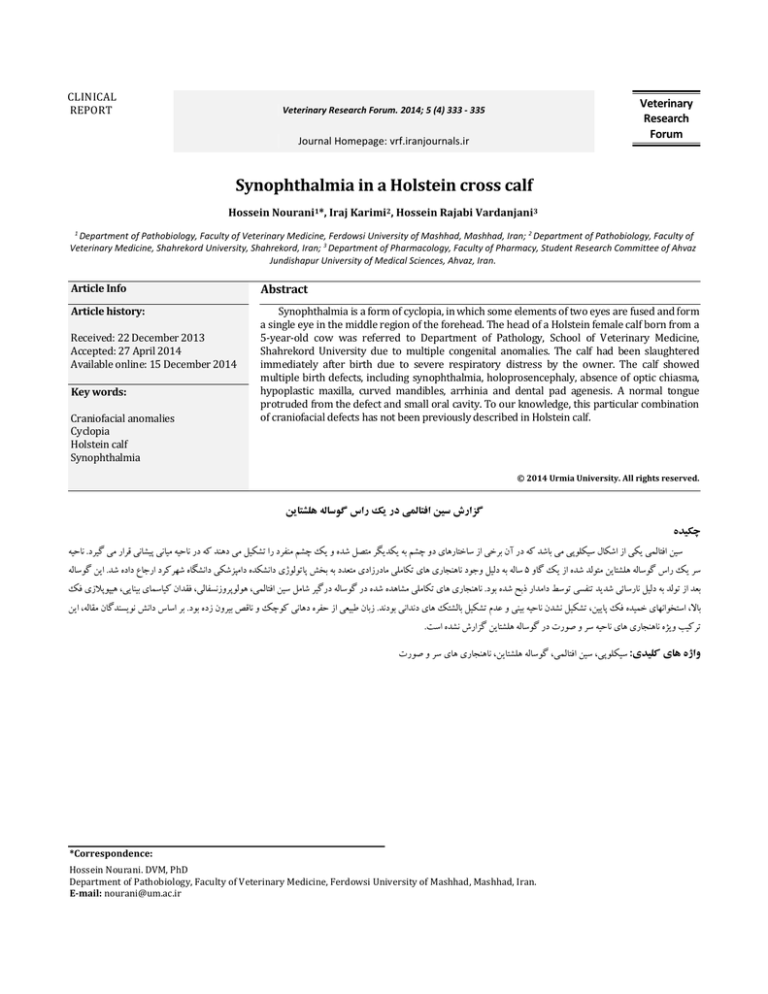
CLINICAL
REPORT
Veterinary
Research
Forum
Veterinary Research Forum. 2014; 5 (4) 333 - 335
Journal Homepage: vrf.iranjournals.ir
Synophthalmia in a Holstein cross calf
Hossein Nourani1*, Iraj Karimi2, Hossein Rajabi Vardanjani3
1
Department of Pathobiology, Faculty of Veterinary Medicine, Ferdowsi University of Mashhad, Mashhad, Iran; 2 Department of Pathobiology, Faculty of
Veterinary Medicine, Shahrekord University, Shahrekord, Iran; 3 Department of Pharmacology, Faculty of Pharmacy, Student Research Committee of Ahvaz
Jundishapur University of Medical Sciences, Ahvaz, Iran.
Article Info
Abstract
Article history:
Synophthalmia is a form of cyclopia, in which some elements of two eyes are fused and form
a single eye in the middle region of the forehead. The head of a Holstein female calf born from a
5-year-old cow was referred to Department of Pathology, School of Veterinary Medicine,
Shahrekord University due to multiple congenital anomalies. The calf had been slaughtered
immediately after birth due to severe respiratory distress by the owner. The calf showed
multiple birth defects, including synophthalmia, holoprosencephaly, absence of optic chiasma,
hypoplastic maxilla, curved mandibles, arrhinia and dental pad agenesis. A normal tongue
protruded from the defect and small oral cavity. To our knowledge, this particular combination
of craniofacial defects has not been previously described in Holstein calf.
Received: 22 December 2013
Accepted: 27 April 2014
Available online: 15 December 2014
Key words:
Craniofacial anomalies
Cyclopia
Holstein calf
Synophthalmia
© 2014 Urmia University. All rights reserved.
گزارش سين افتالمي در يك راس گوساله هلشتاين
چکيده
ناحيه.سين افتالمي يكي از اشكال سيكلوپي مي باشد كه در آن برخي از ساختارهاي دو چشم به يكديگر متصل شده و يك چشم منفرد را تشكيل مي دهند كه در ناحيه مياني پيشاني قرار مي گيرد
اين گوساله. ساله به دليل وجود ناهنجاري هاي تكاملي مادرزادي متعدد به بخش پاتولوژي دانشكده دامپزشكي دانشگاه شهركرد ارجاع داده شد5 سر يك راس گوساله هلشتاين متولد شده از يك گاو
هيپوپالزي فك، فقدان كياسماي بينايي، هولوپروزنسفالي، ناهنجاري هاي تكاملي مشاهده شده در گوساله درگير شامل سين افتالمي.بعد از تولد به دليل نارسائي شديد تنفسي توسط دامدار ذبح شده بود
اين، بر اساس دانش نويسندگان مقاله. زبان طبيعي از حفره دهاني كوچك و ناقص بيرون زده بود. تشكيل نشدن ناحيه بيني و عدم تشكيل بالشتك هاي دنداني بودند، استخوانهاي خميده فك پايين،باال
.تركيب ويژه ناهنجاري هاي ناحيه سر و صورت در گوساله هلشتاين گزارش نشده است
ناهنجاري هاي سر و صورت، گوساله هلشتاين، سين افتالمي، سيكلوپي:واژه های کليدی
*Correspondence:
Hossein Nourani. DVM, PhD
Department of Pathobiology, Faculty of Veterinary Medicine, Ferdowsi University of Mashhad, Mashhad, Iran.
E-mail: nourani@um.ac.ir
334
H. Nourani et al. Veterinary Research Forum. 2014; 5 (4) 333 - 335
Introduction
Cyclopia is the presence of a single median orbita that
contains either a single eyeball, true cyclopia or
incompletely fused eyeballs, synophthalmia.1
Over 50 years ago scientists demonstrated that holoprosencephaly and the related craniofacial deformities,
called ‘monkey face lamb disease’ were produced in lamb
fetuses when pregnant ewes grazed on Veratrum
californicum early in gestation.2
In cow, cyclopia has been reported in a brown swiss
cross calf,1 Friesian calf,3 German Fleckvieh calf,4 Hariana
breed calf.5
To the authors’ experiences, this particular combination
of craniofacial defects has not been previously described in
Holstein calf and this report describes macroscopic
characteristics of a unique congenital abnormalities.
There was no optic chiasma. Other important defects
included hypoplastic maxilla, curved mandibles, arrhinia
and dental pad agenesis. A normal tongue was protruded
from the defect and small oral cavity (Figs. 2 and 4).
Case Description
The head of a Holstein female calf born from a 5-yearold cow was referred to Department of Pathobiology,
School of Veterinary Medicine, Shahrekord University, Iran
due to multiple congenital anomalies. There was no record
of disease, treatment and suspicious diet in the history of
dam. The calf was slaughtered immediately after birth due
to severe respiratory distress by the owner. The head was
examined grossly and the anomalies recorded.
The most striking malformation was the presence of a
single median orbita that contained incompletely fused
exophthalmic eyeballs (Figs. 1 and 2). Duplication of anterior
intraocular structures, such as lens and pupil were found
but there was one optic nerve. The brain was primitive
with no cerebral hemispheres (holoprosencephaly) and
gray and white matters differentiation (Fig. 3).
Fig. 2. Synophthalmia (arrow), arrhinia and protrusion of tongue.
*
Fig. 3. Dorsal view of holoprosencephaly. There are no cerebral
hemispheres (arrow), Cerebellum (asterisk).
Fig. 1. Synophthalmia. A single median orbita (arrow) with
incompletely fused exophthalmic eyeballs.
Fig. 4. Lateral view of the head with strongly curved left mandible.
H. Nourani et al. Veterinary Research Forum. 2014; 5 (4) 333 - 335
335
Discussion
References
In this case, the possible cause of the craniofacial
defects could not be ascertained. In sheep and goat,
craniofacial defects such as cyclopia or synophthalmia are
caused by ingestion of plants of Veratrum species. These
anomalies are varied from the extreme malformation,
cyclopia to mildly deformed upper jaws.6
The toxins of Veratrum californicum were shown to be
steroidal alkaloids, primarily cyclopamine.6 Cyclopamine is
teratogenic and inhibits the hedgehog (hh) signal transduction pathway. Mouse embryos cultured in the presence
of cyclopamine, showed cyclopia and the associated
developmental brain defect holoprosencephaly.7 Cyclopamine-induced malformations in chick embryos are
associated with interruption of sonic hedgehog (hh)
mediated dorsoventral patterning of the neural tube and
somites.8 Cyclopamine induced cyclopia is reported in
rabbit embryos too.6
In humans, the synophthalmia is a result of neural
plate misdevelopment syndrome involving the eye, brain,
skull and face. It is well known that synophthalmia is due
to heterogenous causes, most of which to chromosomal
abnormalities.9
In the present case, nose, upper jaw and the cerebral
hemispheres were absent. Similar anomalies have been
reported by Minoru and Katsumi, 1999 in three calf
cases of cyclopia.10
To our knowledge, this particular combination of
craniofacial defects has not been previously described
in Holstein calf.
1. Ozcan K, Gürbulak K, Takçi I, et al. Atypical cyclopia in a
brown swiss cross calf: a case report. Anat Histol
Embryol 2006; 35: 152-154.
2. Welchl KD, Panter KE, Lee ST, et al. Cyclopamineinduced synophthalmia in sheep: defining a critical
window and toxicokinetic evaluation. J Appl Toxicol
2009; 29: 414-421.
3. Hammoda AK, Abdoud MY. Cyclopia in a Friesian calf.
Egypt J Phytopathol 1989; 17(1): 76-82.
4. Schulze U, Distl O. Case report: arhinia and cyclopia in a
German Fleckvieh calf. Dtsch Tierarztl Wochenschr
2006; 113: 236-239.
5. Sharma A, Bhardwaj HR. Atypical cyclopia in a cow calf.
Intas Polivet 2009; 10(11): 260-261.
6. James LF, Panter KE, Gaffield W, et al. Biomedical
applications of poisonous plant research. J Agric Food
Chem 2004; 52: 3211-3230.
7. Williams DL. Congenital abnormalities in production
animals. Vet Clin Food Anim 2010; 26: 477-486.
8. Incardona JP, Gaffield W, Kapur RP, et al. The
teratogenic Veratrum alkaloid cyclopamine inhibits
sonic hedgehog signal transduction. Development
1998; 125: 3553-3562.
9. Ahn BM, Kim WS, Song MY, et al. A case of
synophthalmia with chromosomal anomaly: 46, XX, 15, t (15q, 21q). J Korean Pediatr Soc 1994; 37: 854-860.
10. Minoru H, Katsumi H. Three calf cases of cyclopia. J
Japan Vet Med Assoc 1999; 52(10): 644-647.




